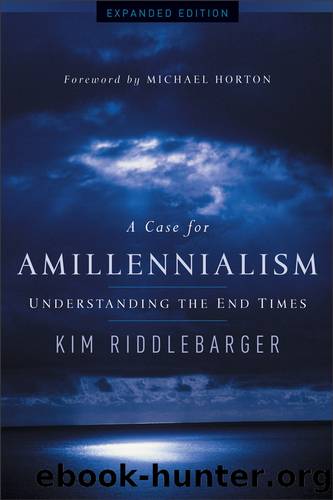A Case for Amillennialism by Kim Riddlebarger

Author:Kim Riddlebarger [Kim Riddlebarger]
Language: eng
Format: epub
Tags: REL006140, REL067060, Millennialism
ISBN: 9781441242662
Publisher: Baker Publishing Group
Published: 2013-07-12T00:00:00+00:00
The Disciplesâ Questions and the Signs of the End
The Olivet Discourse began when Jesus and his disciples left the temple. The immediate context was the aftermath of what Jesus had just said, pronouncing seven woes upon the religious leaders of Israel and then declaring that Israel would be left desolate. As recorded in Matthew 23:37â39, Jesus longed for Israel to repent and come to him in faith, but the people were not willing. He lamented that the house of Israel would become desolate. These difficult words certainly prompted the discussion and questions that followed.
According to Matthew 24, âJesus left the temple and was walking away when his disciples came up to him to call his attention to its buildingsâ (v. 1). The temple was a magnificent structure, and the disciples regarded it with awe and reverence, especially since they were tourists in the city. Josephus notes that the temple âwas built of hard, white stones, each of which was about 25 cubits (35 feet) in length, 8 in height (11 feet) and 12 in width (17 feet).â[11] The temple dominated the cityâs skyline and was Israelâs historic and religious heart. As they left the temple grounds together, especially with what Jesus had just said to the Pharisees and teachers of the law in mind, the disciples called Jesusâs attention to the magnificent buildings before them.
During his earthly ministry, Jesus had said many shocking things. But this might have been the most shocking of all: ââDo you see all these things?â he asked. âI tell you the truth, not one stone here will be left on another; every one will be thrown downââ (v. 2). As they stood in the courtyard of this magnificent building, Jesus told them plainly that it would be destroyed so thoroughly that not one stone would be left on another. Certainly, Luke 19:43â44 is a prophetic foretelling of this event when Jesus said of Jerusalem, âThe days will come upon you when your enemies will build an embankment against you and encircle you and hem you in on every side. They will dash you to the ground, you and the children within your walls. They will not leave one stone on another.â When the Roman army subsequently laid siege to the city, sacked it, and destroyed the temple, Jesusâs words were fulfilled in frightening exactness.
The disciples, no doubt, knew of the prophecies in Jeremiah 9 and 11 and Micah 3 that foretold the destruction of the first temple. Clearly, they thought, if this second even more glorious temple was going to be destroyed, Jesus must be speaking of the end of the age. Imagine standing in the middle of the mall in Washington, DC, looking toward the Capitol Building, the Lincoln and Washington Monuments, and the White House, and then being told that all these things would be destroyed. It would only be natural to conclude that the destruction must be equated with the end of the American republic. This is why at the first available moment of privacy the disciples sought answers from Jesus.
Download
This site does not store any files on its server. We only index and link to content provided by other sites. Please contact the content providers to delete copyright contents if any and email us, we'll remove relevant links or contents immediately.
Crystal Healing for Women by Mariah K. Lyons(7586)
Tools of Titans by Timothy Ferriss(7576)
The Witchcraft of Salem Village by Shirley Jackson(6884)
Inner Engineering: A Yogi's Guide to Joy by Sadhguru(6278)
The Four Agreements by Don Miguel Ruiz(6061)
The Power of Now: A Guide to Spiritual Enlightenment by Eckhart Tolle(5143)
The Wisdom of Sundays by Oprah Winfrey(4841)
Secrets of Antigravity Propulsion: Tesla, UFOs, and Classified Aerospace Technology by Ph.D. Paul A. Laviolette(4637)
Room 212 by Kate Stewart(4540)
Pale Blue Dot by Carl Sagan(4411)
Fear by Osho(4353)
The David Icke Guide to the Global Conspiracy (and how to end it) by David Icke(4242)
Rising Strong by Brene Brown(4059)
Animal Frequency by Melissa Alvarez(4008)
How to Change Your Mind by Michael Pollan(3978)
Sigil Witchery by Laura Tempest Zakroff(3903)
Real Magic by Dean Radin PhD(3800)
The Art of Happiness by The Dalai Lama(3688)
Man and His Symbols by Carl Gustav Jung(3684)
